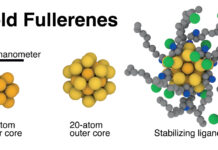
Laser can Spin Electrons Right Round in 2D Material: In thin, two-dimensional semiconductors, electrons move, spin and synchronize in unusual ways. For researchers, understanding the way these electrons carry out their intricate dances— and learning to manipulate their choreography—not only lets them answer fundamental physical questions, but can yield new types of circuits and devices.
One correlated phase that such electrons can take on is magnetic order, in which they align their spin in the same direction. Traditionally, the ability to manipulate magnetic order within a 2-D semiconductor has been limited; scientists have used unwieldy, external magnetic fields, which limit technological integration and potentially conceal interesting phenomena.
Now, researchers from the University of Chicago’s Pritzker School of Molecular Engineering (PME) have discovered how to use nanoscale, low-power laser beams to precisely control magnetism within a 2-D semiconductor. Their approach, described online in the journal Science Advances, has implications for both studying the emergence of the correlated phase as well as designing new optoelectronic and spintronic devices.
Laser can Spin Electrons Right Round in 2D Material: High’s lab focused on transition metal dichalcogenides (TMDs), a family of semiconductors that can be exfoliated into single, two-dimensional flakes, measuring just three atoms thick. Scientists had previously hypothesized that electrons within TMDs could assume a correlated phase, with their spin aligned in the same direction to lower the system energy—this ferromagnetic phase is what we colloquially call magnetism. Generating or modeling this transition to the correlated state, however, has been difficult.
High has long been interested in how light can be controlled and, in turn, can alter states of matter. His team wondered whether, instead of external magnetic fields, miniscule beams of light could be used to create a correlated magnetic phase. They aimed a tightly-focused laser beam, less than a micron (one-thousandth of a millimeter) in diameter at a monolayer TMD. They flashed the laser for nanoseconds at a time, while also monitoring the TMD with an optical probe that let them track the activity of its electrons.
The probe revealed that the pulsing laser was impacting the spin-polarization of electrons within a 5 micron by 8 micron area of the TMD, spreading a correlated phase outward from the laser. In other words, the electrons were aligning their spin; the researchers could control the magnetic order of electrons within the tiny area.
“This new technique provides us a handy way to manipulate electron correlation, making the study of the correlated phases much more practical than it has been in the past,” said postdoctoral fellow Kai Hao, co-first author of the paper.
“One of the things that makes this really attractive is the rather straightforward nature of it,” said graduate student Andrew Kindseth, who also contributed to the new work. “In many ways, it’s as simple as just shining a circularly polarized laser on this material.”
A New Research Platform
Laser can Spin Electrons Right Round in 2D Material: The new technique for controlling magnetism in atomically thin semiconductors offers a jumping off point for a plethora of new studies, the researchers said.
Besides magnetic phases, TMD systems have also been hypothesized to form more exotic correlated electronic phases such as Wigner crystals, charge density waves, Mott states and superconductivity. The capability to locally manipulate the electron spins in TMDs within an ultrashort timescale and with nanoscale precision may provide previously inaccessible information, which will further aid the theoretical study of these exotic phases.
On the application side, there is an urgent need for novel optoelectronic and spintronic devices to meet the explosive growth in the information industry. The demonstration of efficient optical control of spin order has great potential for device applications. Immediate impacts include building on-chip spin sources, tunable optical isolators, and efficient fan-out in spintronic circuits.
“The capability to optically manipulate magnetic memory and generate spin amplification in TMDs – materials widely studied for next-generation technologies – will push optoelectronics and spintronics in new directions,” said graduate student Robert Shreiner, a co-first author of the paper.
Citation: “Optically controllable magnetism in atomically thin semiconductors,” Hao et al, Science Advances, September 30, 2022.
LINK: https://science.org/doi/10.1126/sciadv.abq7650
Funding: National Science Foundation, Army Research Office
—Additional story contribution by Kai Hao, Andrew Kindseth, and Robert Shreiner.
Laser can Spin Electrons Right Round in 2D Material: Original Article
Lightweight metal foam blocks blastwave, debris from high-explosive rounds











